Day 4 Wind and Eight Bells
Last night the wind scoured the camp. The tents flapped and whipped and it made sleeping difficult. I thought of just climbing out but it was cold and I would have had to sleep with the men in the three sided shelter, and hesitated in case it looked like an invitation. At my age and size and with four young men? Who am I kidding?
The site was spectacular. We had climbed a high dune and swung around so we were facing across peak after dark peak marching off across the desert and fading into velvety moonlight. The moon was only about a quarter, but cast good blue light. There were silvery scudding clouds and the mackerel sky was shimmering in one section of the sky. Those who had looked at my location as too exposed were right. I was too exposed. I had looked at theirs and thought "not level' and I was right too - it was really just a matter of choice. Only one tent managed the whole night - Jean Daniel and Marita had edged into a separate section at the top which was both level and moderately sheltered.
I crept out at about 1.00 am cursing the last hot khakadeh. It was enticing and delicious, but added to a hot anise tea, a half bottle of water and one of Alberto's beers earlier on it was perhaps not wise while camping in cold weather. I tied off the door ties which were frantically whacking against anything in reach, and tied one to the little front 'hood' which was acting like a noisy wind tunnel. I crawled back into a quieter tent, positioned myself in the bag and went to sleep. For about one hour.
Then the tent fell down. It was a simple tent - two vertical poles, centre front and centre back, and a 'roofline' pole horizontal pole on top of both. It was pinned in at the corners with spikes well pushed into unresisting soft sand with large rocks on each and guyed down well.
My head-end fell down. It cracked me on the head as it all slithered sideways, the spikes obviously lifted out and all of it wrapped around my head. With a bit of muttered cursing I managed to work out that only the head end had collapsed, so I reversed my position, clamped my feet over the lifting 'vertical' bar that was now horizontal and trying to flap in the wind, and went back to sleep, head downhill. It was a slightly propped burrow at this point. Through my weary fog I heard voices, and found in the morning that everyone's tent except Jean Daniel's and Marita's had also collapsed. Irene had chosen to stay sleeping in the chaos and a concerned Heide trying to find her in pitch dark had managed to find only her nose projecting from the flat but flapping debris.
Next morning was a bit slow moving with everyone weary. We drove for what is generally acknowledged to be the largest meteorite strike crater fields on earth - or at least the largest multi-crater field. On the Western desert map it is simply the Gilf Kebir Crater Field.
We had been told we would be there about midday and at ten Jean Daniel and I were speculating about the old lake beds - lots of little ones - that we seemed to be going through. The sand was getting redder so the areas were spectacular but we saw none of the high and half melted rims I might have expected for a crater field. We were wrong - we were in the crater fields.
The first one we stepped out into almost took my breathe away. I didn't actually take many photos as the first thing I saw on the ground was a lot of worked flint. I am a tool freak from Syria and Jordan days. The site itself was a greyish scatter of a lot of rock on sand, and a lot of the rock was obviously melted or fused - like conglomerate but obviously melted together.
Not only was there worked flint, but a few minutes later I picked up a lovely arrow head in worked glass. Dark and smoky with perfect edges, it glistened in my palm as it it were made yesterday. A group of the others were clustered around Yvonne, our geological and archaeological expert - some metres away. I called out "I have obsidian". "No, it's glass," said Yvonne. I had that vaguely 'back in your corner' feeling! In fact she was completely right - it was the result of a melting of sand or rock which turned to to glass - obsidian is a volcanic reaction that results in glass.
Within minutes I had about six good blades in glass, a few more obscure pieces, and a really nice piece of quartzite made into what I thought was just a first flake, till I realised it has been retouched all along a wide edge to make a semicircular scraper.
I was settling in for an hour or so - I could see more ahead but others had gone in a different direction, I was obviously in a napping area, and I was happy just working my way steadily along a line. Then the horn went as the 'back in the car' signal. I could have cried. I carefully took two good blades and the scraper and put the rest back - as we had all agreed we would do - but it hurt!
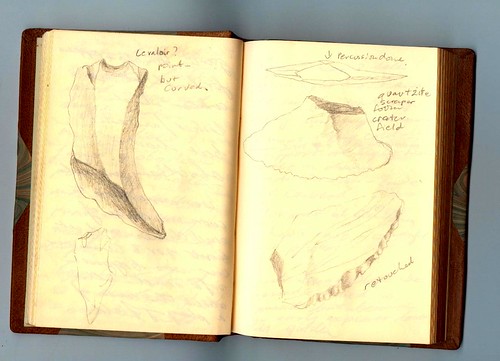
I got back in the car. Later it turned out that others had not seen tools and did not realise they were there. Many wished I had told them - and I had thought that they knew as Heide has done the trip before, as had Yvonne.
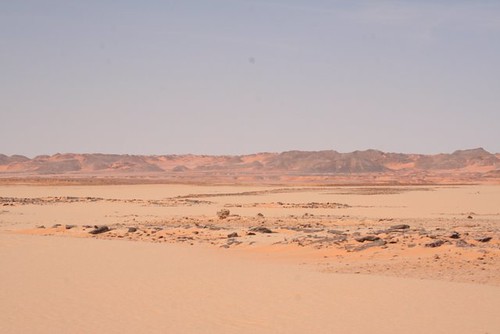
Vistas into the red desert
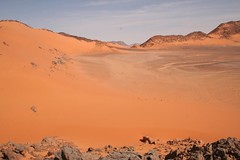
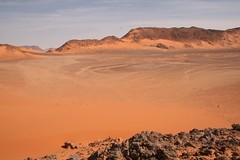
One end of the red crater
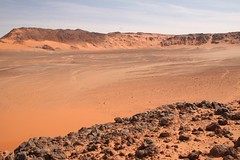

and the other end
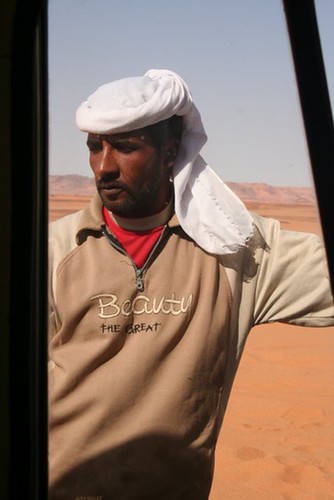 Mohamed in a great t-shirt
Mohamed in a great t-shirt
Lunch was in another crater - wonderful, and red, and a much more classic shape with a black double rim and rich orange sand.
I took a few minutes out of the walking tour to paint it but I am matting with masking tape to keep the paintings small so they can be finished. I tried to paint in the Sugarloaf area and had not hope of finishing and it was just frustrating.
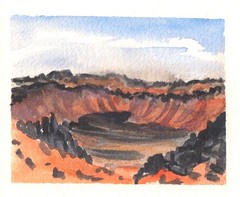
We ate a spectacular main dish of eggplant fast becoming my favourite lunch - fried in about a bucket of oil and smooshed a bit with pounded peppers and chilies and loads of garlic and tomato - a wonderful mix that was a good mopped with bread as eaten with the eggplant.
We crossed an area of sand dunes. We were now the lead car as Mahmoud had decided to drive us for a while.
Hani took taciturn to unexpected heights and had driven in seamless silence, Mahmoud filled us in with all sorts of interesting bits of information. Heide and Helena and Irene were with Hani and had taken third place. At one point we were bogged eight times in an area the size of a playing field. We had sand slides and digging equipment - and I did not see one man groan or look exasperated - though I was starting to feel it. We finally got out, then it was Alberto's turn.
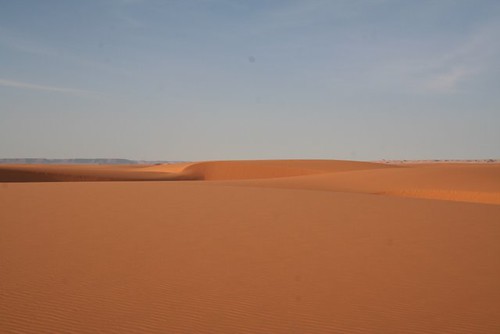
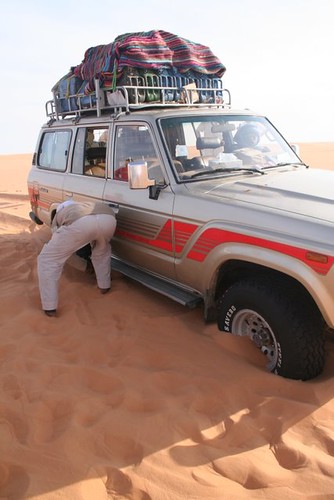
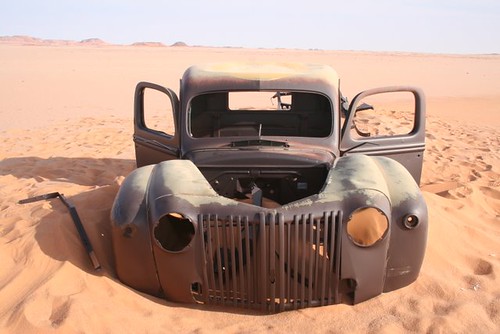
We passed a truck abandoned during the war and now stripped to metal by sand. I knew just how it felt after last night.
In many ways is was a slow day. We camped just before Eight Bells, a site named by the British in the war for the eight hillocks that sat low, domed and squat on the desert floor like bells. It sat above the entrance of Wadi Wassa, the largest of the wadis. We ate a meat based dinner - it was very cold and for the first time I started to wonder about the wisdom of obeying my dear friend Peter and his 'only one small bag'. Everyone else had bags that would fit a small body and my warmest garment was a pair of dark charcoal First Class pyjamas my husband had scored once as the result of an upgrade! They were admittedly Givenchy and that rated an extra degree or two - but I was cold.
We were poised near the 700 metre mark and bed felt very good that night.
The site was spectacular. We had climbed a high dune and swung around so we were facing across peak after dark peak marching off across the desert and fading into velvety moonlight. The moon was only about a quarter, but cast good blue light. There were silvery scudding clouds and the mackerel sky was shimmering in one section of the sky. Those who had looked at my location as too exposed were right. I was too exposed. I had looked at theirs and thought "not level' and I was right too - it was really just a matter of choice. Only one tent managed the whole night - Jean Daniel and Marita had edged into a separate section at the top which was both level and moderately sheltered.
I crept out at about 1.00 am cursing the last hot khakadeh. It was enticing and delicious, but added to a hot anise tea, a half bottle of water and one of Alberto's beers earlier on it was perhaps not wise while camping in cold weather. I tied off the door ties which were frantically whacking against anything in reach, and tied one to the little front 'hood' which was acting like a noisy wind tunnel. I crawled back into a quieter tent, positioned myself in the bag and went to sleep. For about one hour.
Then the tent fell down. It was a simple tent - two vertical poles, centre front and centre back, and a 'roofline' pole horizontal pole on top of both. It was pinned in at the corners with spikes well pushed into unresisting soft sand with large rocks on each and guyed down well.
My head-end fell down. It cracked me on the head as it all slithered sideways, the spikes obviously lifted out and all of it wrapped around my head. With a bit of muttered cursing I managed to work out that only the head end had collapsed, so I reversed my position, clamped my feet over the lifting 'vertical' bar that was now horizontal and trying to flap in the wind, and went back to sleep, head downhill. It was a slightly propped burrow at this point. Through my weary fog I heard voices, and found in the morning that everyone's tent except Jean Daniel's and Marita's had also collapsed. Irene had chosen to stay sleeping in the chaos and a concerned Heide trying to find her in pitch dark had managed to find only her nose projecting from the flat but flapping debris.
Next morning was a bit slow moving with everyone weary. We drove for what is generally acknowledged to be the largest meteorite strike crater fields on earth - or at least the largest multi-crater field. On the Western desert map it is simply the Gilf Kebir Crater Field.
We had been told we would be there about midday and at ten Jean Daniel and I were speculating about the old lake beds - lots of little ones - that we seemed to be going through. The sand was getting redder so the areas were spectacular but we saw none of the high and half melted rims I might have expected for a crater field. We were wrong - we were in the crater fields.
The first one we stepped out into almost took my breathe away. I didn't actually take many photos as the first thing I saw on the ground was a lot of worked flint. I am a tool freak from Syria and Jordan days. The site itself was a greyish scatter of a lot of rock on sand, and a lot of the rock was obviously melted or fused - like conglomerate but obviously melted together.
Not only was there worked flint, but a few minutes later I picked up a lovely arrow head in worked glass. Dark and smoky with perfect edges, it glistened in my palm as it it were made yesterday. A group of the others were clustered around Yvonne, our geological and archaeological expert - some metres away. I called out "I have obsidian". "No, it's glass," said Yvonne. I had that vaguely 'back in your corner' feeling! In fact she was completely right - it was the result of a melting of sand or rock which turned to to glass - obsidian is a volcanic reaction that results in glass.
Within minutes I had about six good blades in glass, a few more obscure pieces, and a really nice piece of quartzite made into what I thought was just a first flake, till I realised it has been retouched all along a wide edge to make a semicircular scraper.
I was settling in for an hour or so - I could see more ahead but others had gone in a different direction, I was obviously in a napping area, and I was happy just working my way steadily along a line. Then the horn went as the 'back in the car' signal. I could have cried. I carefully took two good blades and the scraper and put the rest back - as we had all agreed we would do - but it hurt!

I got back in the car. Later it turned out that others had not seen tools and did not realise they were there. Many wished I had told them - and I had thought that they knew as Heide has done the trip before, as had Yvonne.

Vistas into the red desert


One end of the red crater


and the other end
 Mohamed in a great t-shirt
Mohamed in a great t-shirtLunch was in another crater - wonderful, and red, and a much more classic shape with a black double rim and rich orange sand.
I took a few minutes out of the walking tour to paint it but I am matting with masking tape to keep the paintings small so they can be finished. I tried to paint in the Sugarloaf area and had not hope of finishing and it was just frustrating.

We ate a spectacular main dish of eggplant fast becoming my favourite lunch - fried in about a bucket of oil and smooshed a bit with pounded peppers and chilies and loads of garlic and tomato - a wonderful mix that was a good mopped with bread as eaten with the eggplant.
We crossed an area of sand dunes. We were now the lead car as Mahmoud had decided to drive us for a while.

Hani took taciturn to unexpected heights and had driven in seamless silence, Mahmoud filled us in with all sorts of interesting bits of information. Heide and Helena and Irene were with Hani and had taken third place. At one point we were bogged eight times in an area the size of a playing field. We had sand slides and digging equipment - and I did not see one man groan or look exasperated - though I was starting to feel it. We finally got out, then it was Alberto's turn.



We passed a truck abandoned during the war and now stripped to metal by sand. I knew just how it felt after last night.
In many ways is was a slow day. We camped just before Eight Bells, a site named by the British in the war for the eight hillocks that sat low, domed and squat on the desert floor like bells. It sat above the entrance of Wadi Wassa, the largest of the wadis. We ate a meat based dinner - it was very cold and for the first time I started to wonder about the wisdom of obeying my dear friend Peter and his 'only one small bag'. Everyone else had bags that would fit a small body and my warmest garment was a pair of dark charcoal First Class pyjamas my husband had scored once as the result of an upgrade! They were admittedly Givenchy and that rated an extra degree or two - but I was cold.
We were poised near the 700 metre mark and bed felt very good that night.


0 Comments:
Post a Comment
<< Home